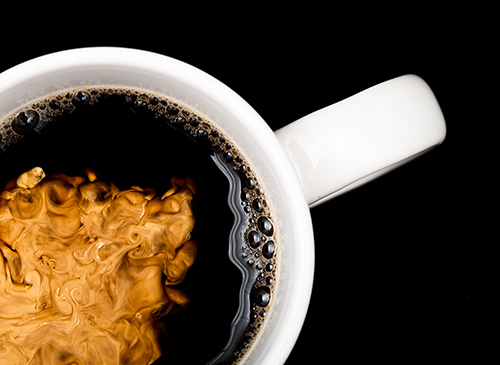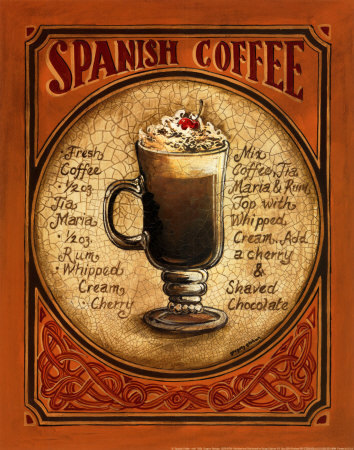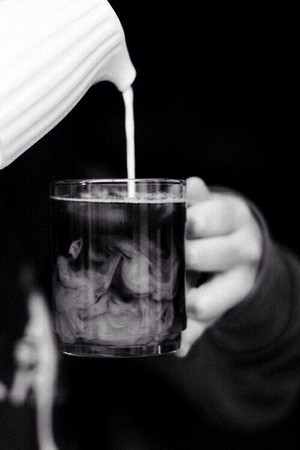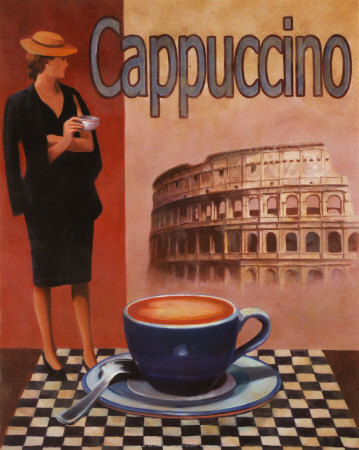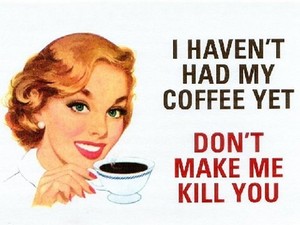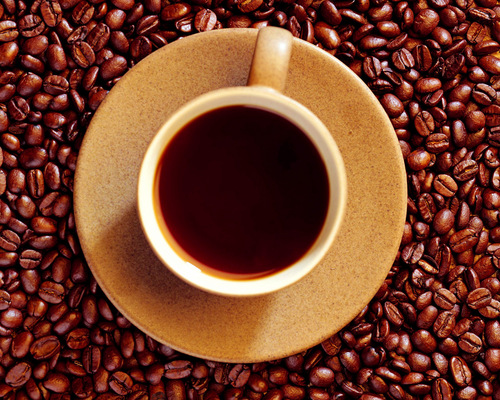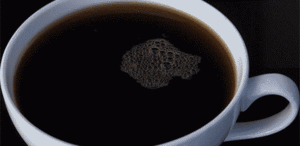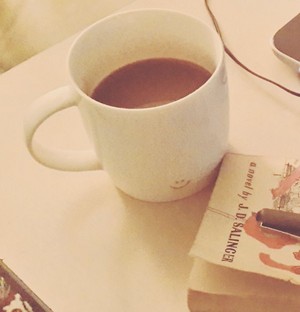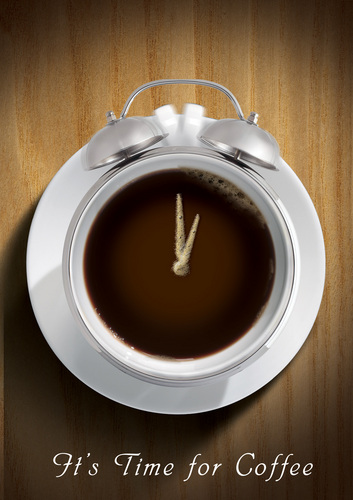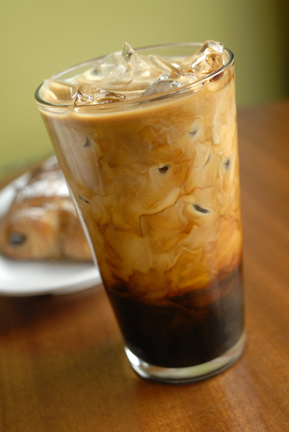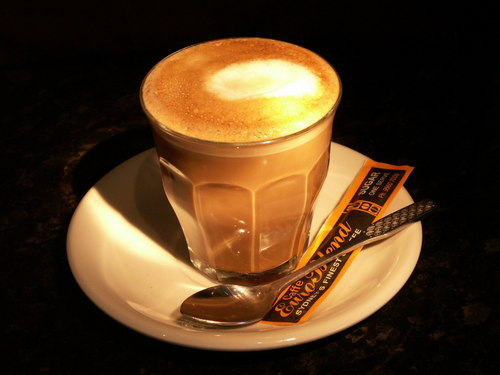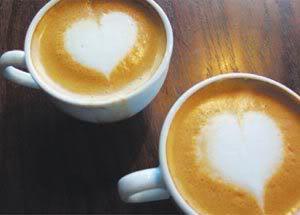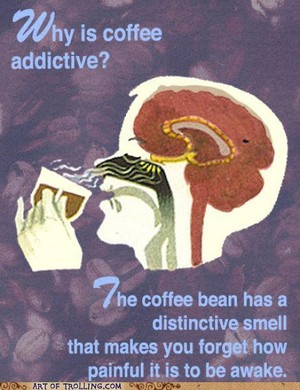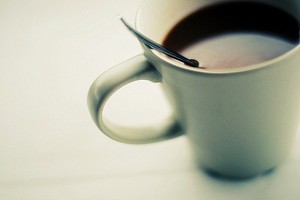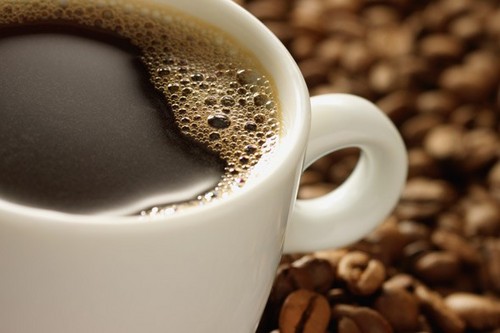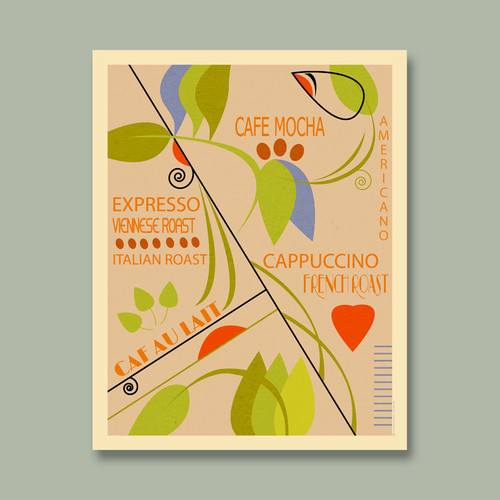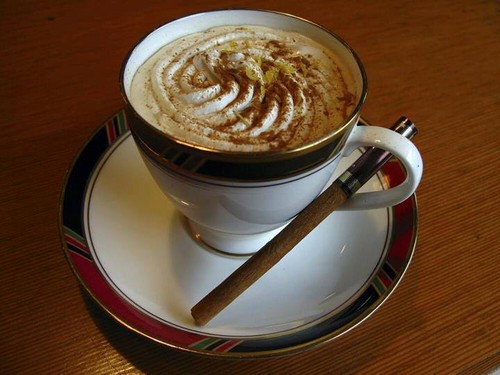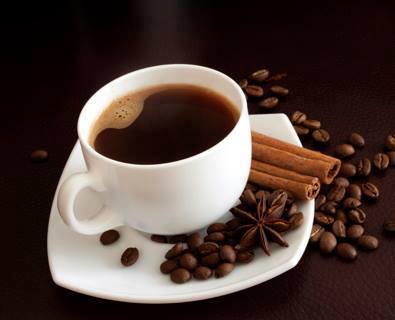1. Affogato (Italian for "drowned") - is a coffee - based beverage or dessert. "Affogato style", which refers to the act of topping a drink or dessert with espresso, may also incorporate caramel sauce or chocolate sauce 2. Antoccino - is a single shot of espresso with steamed milk in a 1:1 ratio, served in an espresso cup. 3. Black Eye - is dripped coffee with a double shot of espresso. It has a strong taste. 4. Black Tie - A traditional Thai Iced Tea, which is a spicy and sweet mixture of chilled black tea, orange blossom water, star anise, crushed tamarind, sugar and condensed milk or cream, with a double shot of espresso. 5. Breve - Beverage made with steamed half and half cream
6. Caffè Americano - or simply Americano is a style of coffee prepared by adding hot water to espresso, giving a similar strength to but different flavor from regular drip coffee. The drink consists of a single or double-shot of espresso combined with between 1 and 16 fluid ounces (30 - 470ml) of hot water. The strength of an Americano varies with the number of shots of espresso added. In the United States, "Americano" is used broadly to mean combining hot water and espresso in either order, but in a narrower definition it refers to adding water to espresso (espresso on the bottom), while adding espresso to water (espresso on the top) is instead referred to as a long black. Variations include: Long black, Lungo, Red eye
7. Café au lait - is traditionally the French way of preparing 'coffee with milk' both at home and in Cafés in Europe. "Café au lait" stems from the same continental tradition as "caffè Latte" in Italy, "café con leche" in Spain, "kawa biała" ("white coffee") in Poland, "Milchkaffee" in Germany, "Mèlange" in Austria, "koffie verkeerd" in Netherlands, and "café com leite" in Portugal, meaning simply "coffee with milk". In northern Europe, café au lait is the name most often used in coffee shops for what other places is a 'caffè latte'. The term 'café au lait' has been used for espresso + milk since the 1950s in among other places the UK, Netherland, Belgium, Germany, Denmark, Norway and Sweden. In the US, 'café au lait' is defined as a coffee beverage consisting strong or bold coffee (sometimes espresso) mixed with scalded milk in approximately a 1:1 ratio.
8. Café Bombón - was made popular in Valencia, Spain, and spread gradually to the rest of the country. It might have been re-created and modified to suit European tastebuds as in many parts of Asia such as Malaysia, Thailand and Singapore the same recipe for coffee which is called "Kopi Susu Panas" (Malaysia) or "Gafeh Rorn" [lit: hot coffee] (Thailand) has already been around for decades and is very popular in "mamak" stalls and "kopitiams" in Malaysia. A café bombón, however uses espresso served with sweetened condensed milk in a 1:1 ratio whereas the Asian version uses ground coffee and sweetened condensed milk at the same ratio. For café bombón, the condensed milk is added to the espresso. For visual effect, a glass is used, and the condensed milk is added slowly to sink underneath the coffee and create two separate bands of contrasting colour – though these layers are customarily stirred together before consumption. Some establishments merely serve an espresso with a sachet of condensed milk for patrons to make themselves.
9. Café Cubano - Café Cubano (Cuban coffee, Cuban espresso, cafecito, Cuban pull, Cuban shot) is a type of espresso which originated in Cuba after espresso machines were first imported there from Italy. Specifically, it refers to an espresso shot which is sweetened with demerara sugar as it is being brewed, but the name covers other drinks that use Cuban espresso as their base. Drinking café cubano remains a prominent social and cultural activity within Cuba, Miami, West Palm Beach, Tampa and the Keys, as well as the Cuban exile community. Café Cubano is available in almost all coffee shops in Miami, making it a staple of local cuisine and tradition.
10. Caffè crema - (Italian: cream coffee) refers to two different coffee drinks:
* - An old name for espresso (1940s and 50s).
** - A long espresso drink primarily served in Switzerland and Austria and northern Italy (1980s onwards), along the Italian/ Swiss and Italian/ Austrian border. As a colorful term it generally means "espresso", while in technical discussions, referring to the long drink, it may more narrowly be referred to as Swiss caffè crema. Variant terms include "crema caffè" and the hyperforeignism "café crema" – "café" is French, while "caffè" and "crema" are Italian, thus "café crema" mixes French and Italian.
11. Café de olla - Café de olla or pot coffee is a traditional coffee-based drink prepared using earthen clay pots or jars in Mexico and other Latin American countries. It is flavored with cinammon and piloncillo. Consumed primarily in colder weathers, usually with the merienda meal, and accompanied with pan dulce pastries.
12. Caffè latte - Similar to the Portuguese Galão, a latte is a portion of espresso and steamed milk, generally in a 1:3 to 1:5 ratio of espresso to milk, with a little foam on top.
13. Caffè Marocchino - is made from espresso, steamed milk, and a dusting of cocoa powder, similar to the espressino.
14. Caffè Medici - is a doppio poured over chocolate syrup and orange peel, usually topped with whipped cream. The drink originated at Seattle's historic Last Exit on Brooklyn coffeehouse.
15. Café miel - has a shot of espresso, steamed milk, cinnamon, and honey. The name comes from the French word for honey, miel.
16. Coffee milk - is a drink similar to chocolate milk; however, instead of chocolate syrup, coffee syrup is used. It is the official state drink of Rhode Island in the United States.
17. Café mocha - is a variant of a caffè latte. Like a latte, it is typically one third espresso and two thirds steamed milk, but a portion of chocolate is added, typically in the form of a chocolate syrup, although other vending systems use instant chocolate powder. Mochas can contain dark or milk chocolate.
The term moccaccino is used in some regions of Europe and the Middle East to describe caffè latte with cocoa or chocolate. In the U.S. it usually refers to a cappuccino made with chocolate. A "cafe borgia" is a mocha with orange rind and sometimes orange flavoring added. Often served with whipped cream and topped with cinnamon.
18. Caffè Tobio - is an espresso drink with an equal amount of regular coffee. This combination simultaneously helps the flavor of weak coffee and hides the bitter flavor of espresso. Useful in chain coffee bars.[6]
19. Café Touba - is the spiritual beverage of Senegal, named for the holy city of Touba. During the roasting process, the coffee beans are mixed with grains of selim, and sometimes other spices, and ground into powder after roasting. The drink is prepared using a filter, similar to plain coffee. Sugar is often added before drinking.
20. Cafe Zorro - is a double espresso, or doppio, added to hot water with a 1:1 ratio.
21. Ca phe sua da - also known as, cafe sua da (Vietnamese: Cà phê sữa đá) or "V-caf", is a unique Vietnamese coffee recipe. Literally, ca phe sua da means "iced milk coffee" and it can be made simply by mixing black coffee with about a quarter to a half as much sweetened condensed milk and then pouring it over ice. The coffee is traditionally brewed with a small metal Vietnamese drip filter into a cup containing the condensed milk. The condensed milk and coffee are stirred together and then poured over the ice. Ca phe sua nong (Vietnamese: 'cà phê sữa nóng') — literally, "hot milk coffee" — is made by excluding the ice. ** In Spain, there is a similar beverage called Café del Tiempo ([Summer] Weather Coffee) or Café con Hielo (Coffee with Ice). Similarly, Café Bombón can be served with ice. The coffee is served in a small cup and an empty small glass with ices cubes. Sugar or condensed milk is added in the small cup while the coffee is still hot, and then the coffee is poured in the small glass with ices. When the coffee is cooled, the remaining ice is removed with the help of a spoon.
22. Cappuccino - is a coffee-based drink prepared with espresso, hot milk, and steamed milk foam. A cappuccino differs from a caffè latte in that it is prepared with much less steamed or textured milk than the caffè latte with the total of espresso and milk/foam making up between approximately 150 and 180 millilitres (5 and 6 US fluid ounces). A cappuccino usually exceeds the height of the cup, making the foam visible above the side of the cup. A cappuccino is traditionally served in a porcelain cup, which has far better heat retention characteristics than glass or paper. The foam on top of the cappuccino acts as an insulator and helps retain the heat of the liquid, allowing it to stay hotter longer.
23. Chai Latte - Numerous houses use the term chai latte to indicate that the steamed milk of a normal cafè latte is being flavoured with a spiced tea concentrate instead of with espresso. Add espresso shots for a "Dirty Chai Latte".
24. Cold Brew ,or cold-press - refers to the process of steeping coffee grounds in room temperature or cold water for an extended period. It is also sometimes referred to as Toddy coffee which is a trademarked cold brewing system. The cold brew process requires grinding. Coarse-ground beans are soaked in water for a prolonged period of time, usually 12 hours or more. The water is normally kept at room temperature, but chilled water can also be used. The grounds must be filtered out of the water after they have been steeped using a paper coffee filter, a fine metal sieve, a French press or felt, in the case of the Toddy system. The result is a coffee concentrate that is often diluted with water or milk, and can be served hot, over ice, or blended with ice and other ingredients such as chocolate. Cold brewed coffee naturally seems sweeter due to its lower acidity. It is around 65-70% less acidic than hot drip coffee or espresso. Because the coffee beans in cold brew coffee never come into contact with heated water, the process of leaching flavor from the beans produces a chemical profile different from conventional brewing methods. ** Cold brew coffee is not to be confused with iced coffee, which can refer to coffee that is brewed hot and then chilled by pouring over or adding ice.
25. Cortado - is an espresso (also known as "Pingo" or "Garoto") "cut" (from the Spanish and Portuguese cortar) with a small amount of warm milk to reduce the acidity. The ratio of milk to coffee is between 1:1 – 1:2, and the milk is added after the espresso. The steamed milk hasn't much foam, but many baristas make some micro foam to make latte art. It is popular in Spain and Portugal, in Norway as well as throughout Latin America, where it is drunk in the afternoon. In Cuba, it is known as a cortadito. It's usually served in a special glass, often with a metal ring base and a metal wire handle. There are several variations, including cortado condensada (espresso with condensed milk) and leche y leche (with condensed milk and cream on top). In the United States it is sometimes known as a "Gibraltar". Differs from Cappuccino with little or no milk foam, and from Flat White in that the Flat White is always prepared with a double espresso and no foam.
6. Caffè Americano - or simply Americano is a style of coffee prepared by adding hot water to espresso, giving a similar strength to but different flavor from regular drip coffee. The drink consists of a single or double-shot of espresso combined with between 1 and 16 fluid ounces (30 - 470ml) of hot water. The strength of an Americano varies with the number of shots of espresso added. In the United States, "Americano" is used broadly to mean combining hot water and espresso in either order, but in a narrower definition it refers to adding water to espresso (espresso on the bottom), while adding espresso to water (espresso on the top) is instead referred to as a long black. Variations include: Long black, Lungo, Red eye
7. Café au lait - is traditionally the French way of preparing 'coffee with milk' both at home and in Cafés in Europe. "Café au lait" stems from the same continental tradition as "caffè Latte" in Italy, "café con leche" in Spain, "kawa biała" ("white coffee") in Poland, "Milchkaffee" in Germany, "Mèlange" in Austria, "koffie verkeerd" in Netherlands, and "café com leite" in Portugal, meaning simply "coffee with milk". In northern Europe, café au lait is the name most often used in coffee shops for what other places is a 'caffè latte'. The term 'café au lait' has been used for espresso + milk since the 1950s in among other places the UK, Netherland, Belgium, Germany, Denmark, Norway and Sweden. In the US, 'café au lait' is defined as a coffee beverage consisting strong or bold coffee (sometimes espresso) mixed with scalded milk in approximately a 1:1 ratio.
8. Café Bombón - was made popular in Valencia, Spain, and spread gradually to the rest of the country. It might have been re-created and modified to suit European tastebuds as in many parts of Asia such as Malaysia, Thailand and Singapore the same recipe for coffee which is called "Kopi Susu Panas" (Malaysia) or "Gafeh Rorn" [lit: hot coffee] (Thailand) has already been around for decades and is very popular in "mamak" stalls and "kopitiams" in Malaysia. A café bombón, however uses espresso served with sweetened condensed milk in a 1:1 ratio whereas the Asian version uses ground coffee and sweetened condensed milk at the same ratio. For café bombón, the condensed milk is added to the espresso. For visual effect, a glass is used, and the condensed milk is added slowly to sink underneath the coffee and create two separate bands of contrasting colour – though these layers are customarily stirred together before consumption. Some establishments merely serve an espresso with a sachet of condensed milk for patrons to make themselves.
9. Café Cubano - Café Cubano (Cuban coffee, Cuban espresso, cafecito, Cuban pull, Cuban shot) is a type of espresso which originated in Cuba after espresso machines were first imported there from Italy. Specifically, it refers to an espresso shot which is sweetened with demerara sugar as it is being brewed, but the name covers other drinks that use Cuban espresso as their base. Drinking café cubano remains a prominent social and cultural activity within Cuba, Miami, West Palm Beach, Tampa and the Keys, as well as the Cuban exile community. Café Cubano is available in almost all coffee shops in Miami, making it a staple of local cuisine and tradition.
10. Caffè crema - (Italian: cream coffee) refers to two different coffee drinks:
* - An old name for espresso (1940s and 50s).
** - A long espresso drink primarily served in Switzerland and Austria and northern Italy (1980s onwards), along the Italian/ Swiss and Italian/ Austrian border. As a colorful term it generally means "espresso", while in technical discussions, referring to the long drink, it may more narrowly be referred to as Swiss caffè crema. Variant terms include "crema caffè" and the hyperforeignism "café crema" – "café" is French, while "caffè" and "crema" are Italian, thus "café crema" mixes French and Italian.
11. Café de olla - Café de olla or pot coffee is a traditional coffee-based drink prepared using earthen clay pots or jars in Mexico and other Latin American countries. It is flavored with cinammon and piloncillo. Consumed primarily in colder weathers, usually with the merienda meal, and accompanied with pan dulce pastries.
12. Caffè latte - Similar to the Portuguese Galão, a latte is a portion of espresso and steamed milk, generally in a 1:3 to 1:5 ratio of espresso to milk, with a little foam on top.
13. Caffè Marocchino - is made from espresso, steamed milk, and a dusting of cocoa powder, similar to the espressino.
14. Caffè Medici - is a doppio poured over chocolate syrup and orange peel, usually topped with whipped cream. The drink originated at Seattle's historic Last Exit on Brooklyn coffeehouse.
15. Café miel - has a shot of espresso, steamed milk, cinnamon, and honey. The name comes from the French word for honey, miel.
16. Coffee milk - is a drink similar to chocolate milk; however, instead of chocolate syrup, coffee syrup is used. It is the official state drink of Rhode Island in the United States.
17. Café mocha - is a variant of a caffè latte. Like a latte, it is typically one third espresso and two thirds steamed milk, but a portion of chocolate is added, typically in the form of a chocolate syrup, although other vending systems use instant chocolate powder. Mochas can contain dark or milk chocolate.
The term moccaccino is used in some regions of Europe and the Middle East to describe caffè latte with cocoa or chocolate. In the U.S. it usually refers to a cappuccino made with chocolate. A "cafe borgia" is a mocha with orange rind and sometimes orange flavoring added. Often served with whipped cream and topped with cinnamon.
18. Caffè Tobio - is an espresso drink with an equal amount of regular coffee. This combination simultaneously helps the flavor of weak coffee and hides the bitter flavor of espresso. Useful in chain coffee bars.[6]
19. Café Touba - is the spiritual beverage of Senegal, named for the holy city of Touba. During the roasting process, the coffee beans are mixed with grains of selim, and sometimes other spices, and ground into powder after roasting. The drink is prepared using a filter, similar to plain coffee. Sugar is often added before drinking.
20. Cafe Zorro - is a double espresso, or doppio, added to hot water with a 1:1 ratio.
21. Ca phe sua da - also known as, cafe sua da (Vietnamese: Cà phê sữa đá) or "V-caf", is a unique Vietnamese coffee recipe. Literally, ca phe sua da means "iced milk coffee" and it can be made simply by mixing black coffee with about a quarter to a half as much sweetened condensed milk and then pouring it over ice. The coffee is traditionally brewed with a small metal Vietnamese drip filter into a cup containing the condensed milk. The condensed milk and coffee are stirred together and then poured over the ice. Ca phe sua nong (Vietnamese: 'cà phê sữa nóng') — literally, "hot milk coffee" — is made by excluding the ice. ** In Spain, there is a similar beverage called Café del Tiempo ([Summer] Weather Coffee) or Café con Hielo (Coffee with Ice). Similarly, Café Bombón can be served with ice. The coffee is served in a small cup and an empty small glass with ices cubes. Sugar or condensed milk is added in the small cup while the coffee is still hot, and then the coffee is poured in the small glass with ices. When the coffee is cooled, the remaining ice is removed with the help of a spoon.
22. Cappuccino - is a coffee-based drink prepared with espresso, hot milk, and steamed milk foam. A cappuccino differs from a caffè latte in that it is prepared with much less steamed or textured milk than the caffè latte with the total of espresso and milk/foam making up between approximately 150 and 180 millilitres (5 and 6 US fluid ounces). A cappuccino usually exceeds the height of the cup, making the foam visible above the side of the cup. A cappuccino is traditionally served in a porcelain cup, which has far better heat retention characteristics than glass or paper. The foam on top of the cappuccino acts as an insulator and helps retain the heat of the liquid, allowing it to stay hotter longer.
23. Chai Latte - Numerous houses use the term chai latte to indicate that the steamed milk of a normal cafè latte is being flavoured with a spiced tea concentrate instead of with espresso. Add espresso shots for a "Dirty Chai Latte".
24. Cold Brew ,or cold-press - refers to the process of steeping coffee grounds in room temperature or cold water for an extended period. It is also sometimes referred to as Toddy coffee which is a trademarked cold brewing system. The cold brew process requires grinding. Coarse-ground beans are soaked in water for a prolonged period of time, usually 12 hours or more. The water is normally kept at room temperature, but chilled water can also be used. The grounds must be filtered out of the water after they have been steeped using a paper coffee filter, a fine metal sieve, a French press or felt, in the case of the Toddy system. The result is a coffee concentrate that is often diluted with water or milk, and can be served hot, over ice, or blended with ice and other ingredients such as chocolate. Cold brewed coffee naturally seems sweeter due to its lower acidity. It is around 65-70% less acidic than hot drip coffee or espresso. Because the coffee beans in cold brew coffee never come into contact with heated water, the process of leaching flavor from the beans produces a chemical profile different from conventional brewing methods. ** Cold brew coffee is not to be confused with iced coffee, which can refer to coffee that is brewed hot and then chilled by pouring over or adding ice.
25. Cortado - is an espresso (also known as "Pingo" or "Garoto") "cut" (from the Spanish and Portuguese cortar) with a small amount of warm milk to reduce the acidity. The ratio of milk to coffee is between 1:1 – 1:2, and the milk is added after the espresso. The steamed milk hasn't much foam, but many baristas make some micro foam to make latte art. It is popular in Spain and Portugal, in Norway as well as throughout Latin America, where it is drunk in the afternoon. In Cuba, it is known as a cortadito. It's usually served in a special glass, often with a metal ring base and a metal wire handle. There are several variations, including cortado condensada (espresso with condensed milk) and leche y leche (with condensed milk and cream on top). In the United States it is sometimes known as a "Gibraltar". Differs from Cappuccino with little or no milk foam, and from Flat White in that the Flat White is always prepared with a double espresso and no foam.



